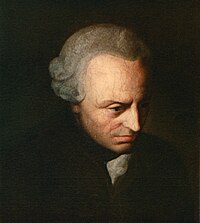1797 work on morals and politics by Immanuel Kant
.mw-parser-output .hidden-begin{box-sizing:border-box;width:100%;padding:5px;border:none;font-size:95%}.mw-parser-output .hidden-title{font-weight:bold;line-height:1.6;text-align:left}.mw-parser-output .hidden-content{text-align:left}@media all and (max-width:500px){.mw-parser-output .hidden-begin{width:auto!important;clear:none!important;float:none!important))You can help expand this article with text translated from
the corresponding article in German. Click [show] for important translation instructions.
Machine translation, like
DeepL or
Google Translate, is a useful starting point for translations, but translators must revise errors as necessary and confirm that the translation is accurate, rather than simply copy-pasting machine-translated text into the English Wikipedia.
Do not translate text that appears unreliable or low-quality. If possible, verify the text with references provided in the foreign-language article.
You must provide
copyright attribution in the
edit summary accompanying your translation by providing an
interlanguage link to the source of your translation. A model attribution edit summary is Content in this edit is translated from the existing German Wikipedia article at [[:de:Die Metaphysik der Sitten]]; see its history for attribution.
You may also add the template ((Translated|de|Die Metaphysik der Sitten)) to the
talk page.
For more guidance, see
Wikipedia:Translation.
The Metaphysics of Morals (German: Die Metaphysik der Sitten) is a 1797 work of political and moral philosophy by Immanuel Kant. It is also Kant's last major work in moral philosophy. The work is divided into two sections: the Doctrine of Right, dealing with political rights, and the Doctrine of Virtue, dealing with ethical virtues.
In this work, Kant develops the political and ethical philosophy for which the Groundwork and Critique of Practical Reason provide the foundation.
General Structure of the Work
The work is divided into two main parts, the Rechtslehre and the Tugendlehre. Mary J. Gregor's translation (1991) explains these German terms as, respectively, the Doctrine of Right, which deals with the rights that people have, and the Doctrine of Virtue, which deals with the virtues they ought to acquire. The Doctrine of Right also deals with required actions concerning the external relationships between people and the Doctrine of Virtue also deals with the internal requirements that characterize moral action and duty.
Rechtslehre has also been translated as the Science of Right (Hastie) or the Metaphysical Elements of Justice (Ladd).
Summary
The Doctrine of Right is grounded in republican interpretation of origins of political community as civil society and establishment of positive law. Published separately in 1797, the Doctrine of Right is one of the last examples of classical republicanism in political philosophy.[1] The Doctrine of Right contains the most mature of Kant's statements on the peace project and a system of law to ensure individual and public rights. It also discusses property rights, how punitive justice should work, as well as state and cosmopolitan rights.
The Doctrine of Virtue develops Kant's ethical theory, which he had already laid the foundation in the Groundwork of the Metaphysics of Morals (1785). Kant particularly emphasizes treating humanity as an end in itself. The duties are analytically treated by Kant, who distinguishes duties towards ourselves from duties towards others. The duties are classified as perfect duties and imperfect duties. Kant thinks imperfect duties allow a latitudo, i.e., the possibility of choosing maxims. The perfect duties instead do not allow any latitudo. Kant uses this distinction in discussing some of the duties that were shown as examples in the Groundwork in more detail (viz., not lying, not committing suicide, cultivating one's talents, and being beneficent toward others).
Thus, Kant distinguishes "Virtue" and "Right": the "Doctrine of Right" contains rights as perfect duties towards others only.
Influence
In the English-speaking world, the Metaphysics of Morals (1797) is not as well known as Kant's earlier works, the Groundwork of the Metaphysics of Morals (1785) and the Critique of Practical Reason (1788), but it has experienced a renaissance through the pioneering work of Mary J. Gregor.[2]
English translations
Translations of the entire book:
Translations of Part I:
- Kant, Immanuel. The Philosophy of Law: An Exposition of the Fundamental Principles of Jurisprudence as the Science of Right. Translated by W. Hastie. Edinburgh: T. & T. Clark, 1887; reprinted by Augustus M. Kelly Publishers, Clifton, NJ, 1974. [introduction and all of part I]
- Kant, Immanuel. The Metaphysical Elements of Justice; Part I of the Metaphysics of Morals. 1st ed. Translated by John Ladd. Indianapolis: Bobbs-Merrill, 1965. [introduction and most of part I]
- Kant, Immanuel. The Metaphysics of Morals. In Kant: Political Writings. 2nd enl. ed. Edited by Hans Reiss. Translated by H. B. Nisbet. Cambridge: Cambridge University Press, 1991. [selections from part I]
- Kant, Immanuel. The Metaphysical Elements of Justice; Part I of the Metaphysics of Morals. 2nd ed. Translated by John Ladd. Indianapolis: Bobbs-Merrill, 1999. [introduction and all of part I]
- Kant, Immanuel. Metaphysics of Morals, Doctrine of Rights, Section 43-section 62. In Toward Perpetual Peace and Other Writings on Politics, Peace, and History. Edited by Pauline Kleingeld. Translated by David L. Colclasure. New Haven: Yale University Press, 2006. [selections from part I, concerning public right]
Translations of Part II:
- Kant, Immanuel, The Doctrine of Virtue. Translated by Mary J. Gregor. New York: Harper & Row Torchbooks, 1964; reprinted by the University of Pennsylvania Press, 1971.
- Translated by James Wesley Ellington, in Ethical Philosophy. Indianapolis: Hackett, 1983 [1964]. [Part II]
- Translated by John William Semple, "The Metaphysic of Ethics." Edinburgh: Thomas Clark, 1836; Reprint editions include 1871, ed. Henry Calderwood (Edinburgh: T. & T. Clark). [Introduction and portions of part II]

